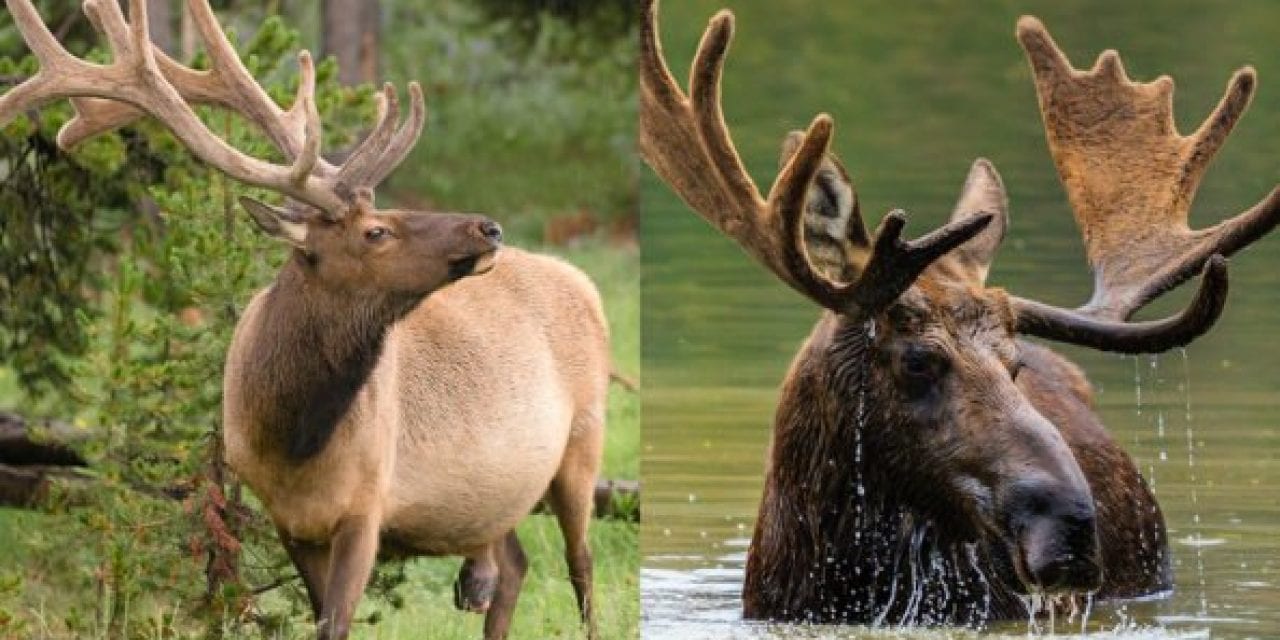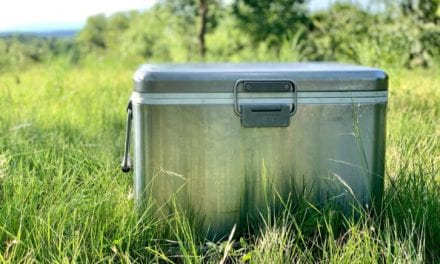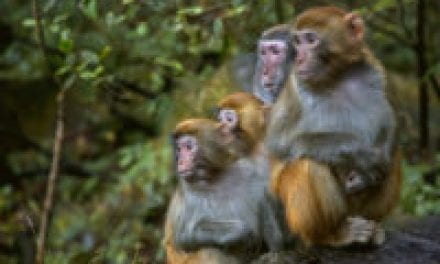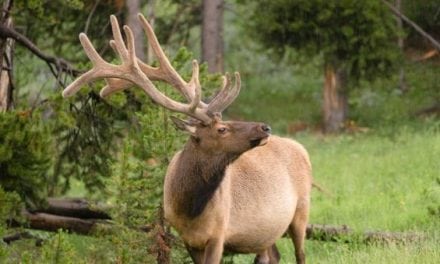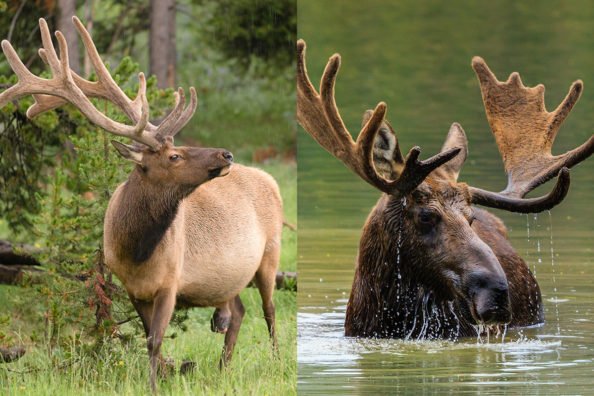
It’s moose vs. elk in a debate that seems to continue on through the ages. We try to determine which is better to hunt and to eat.
The moose and the elk are two of our most favorite big game animals. They are wily, tough to hunt, and their game meat, when properly cared for, is delicious.
They are big, dangerous, and both have a set of antlers that would make every other member or the cervidae family jealous.
To be clear, we’re talking about a bull elk versus a bull moose, not in a wrestling match against each other but instead competing for positioning on our list of favorite hunts, as well as our favorite game to eat.
Where does your preference lie? What animal would you rather pursue, and which would you rather prepare for a meal?
There’s no right or wrong answer, but we’ll investigate the things that make the debate such a viable one.
The Moose
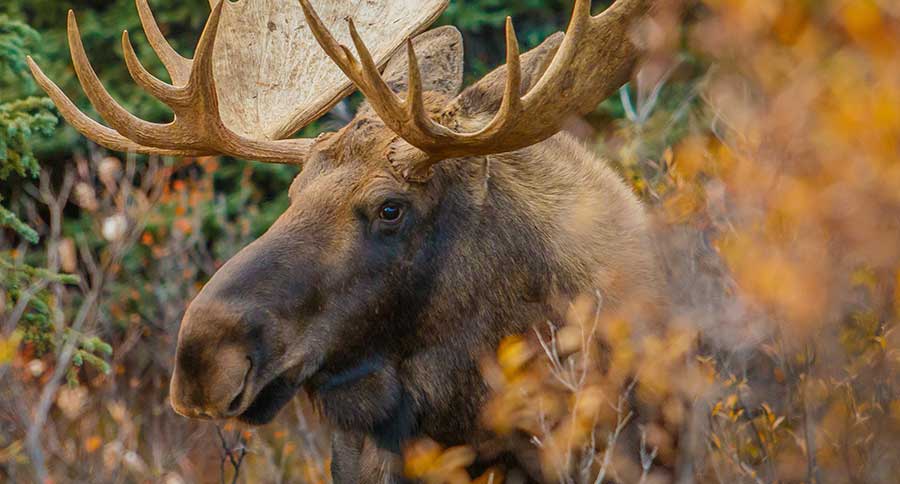
Let’s start with the Alces alces; this big boy is the largest member of the deer family, and though they’re typically slow creatures, they can move very fast and become extremely aggressive when angered or caught by surprise.
They are the tallest mammals in North America, reaching up to six feet at the shoulder. Interestingly enough, that’s roughly the same length that their palmate antlers (the large, flat antlers common on mature moose) can reach, tip to tip.
The moose’s dark brown hair is hollow, which provides them with some serious insulation. Along with their wide hooves for ease of travel in deep snow, these adaptations makes them one of the best surviving creatures in the northern hemisphere.
Both male and female moose sport a dewlap under their chin. It’s a fold of skin that’s thought to be used as a visual and olfactory signal, presumably as a sign of dominance for male moose.
There are moose populations in Northern Europe, portions of the northern and western U.S., and especially Canada, where estimates say there are close to 750,000 moose in the country. Large moose numbers are also found in Finland, Norway, Sweden, and the Baltic states.
Elk live primarily in the western part of North America, although there are some small but viable populations in the eastern U.S. They’re primarily solitary animals, and are rarely seen with other moose outside of the fall mating season. The exception is young calves, which stay with their mothers until they reach about 18 months.
Moose Hunting
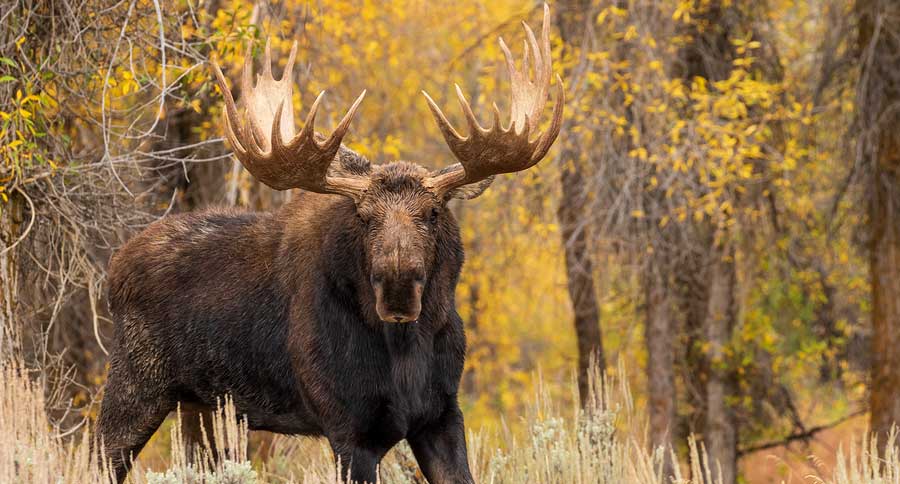
The size and stature of moose make for a truly memorable game animal to hunt. For many serious North American hunters, moose hunting has reached bucket list territory.
You may think that moose hunting begins and ends in places like Alaska, British Columbia and Alberta, Canada, but areas like Maine and even New Hampshire in the eastern U.S. provide quality hunting opportunities as well.
Virtually all of these locations have lottery based drawings for moose tags, with some being more difficult than others to obtain.
As most of these situations go, the smaller states have fewer opportunities, while the larger ones are through the roof with possibilities. In case you’re wanting to get more specific, here’s a list of the five best moose hunting areas in the United States.
Moose calling is a common part of moose hunting, as their vocalizations can do a lot in terms of persuasion. Large caliber rifles and fast-shooting bows are in order, and inadequate firepower can be a recipe for disaster.
Spot and stalk hunting is a common strategy when pursuing moose, and the real work begins after successfully downing one. Even experienced hunters can take hours to fully field dress a moose, and packing moose meat out of a backcountry situation is one of the tougher feats to accomplish for sportsmen and women.
The Elk
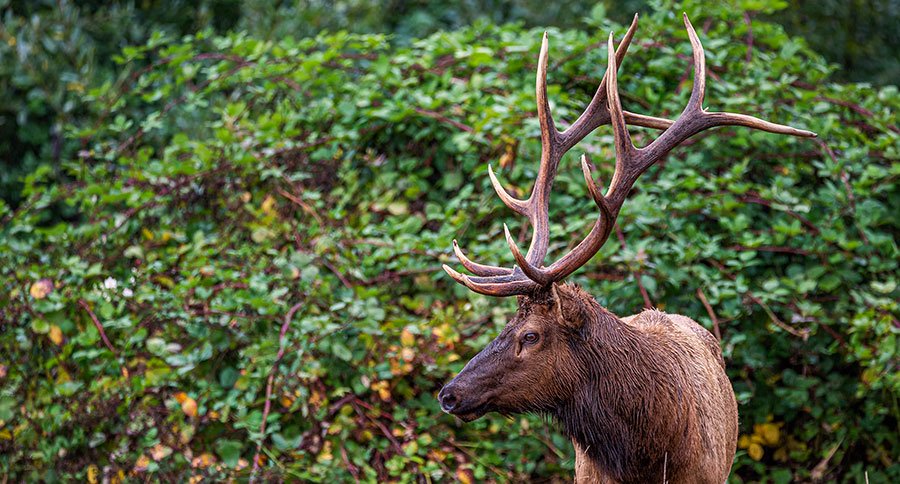
The elk is the second largest deer of the family Cervus canadensis and is sometimes called by its native name, wapiti. Bull elk are large, typically reaching over 700 pounds and around five feet tall at maturity. As a comparison, that’s more than double the size of a mature mule deer. Their dark brown head and neck hair gives way to a light brown color on the body, with a lighter, almost white or buff-colored rump.
Male elk antlers grow the same as all deer, shedding in the winter and regrowing in the spring. Elk have the same distinct bone antlers as their relatives that grow up and away from their skull, sometimes with as many as six tines to a side for a real trophy.
If you take a quick look at this map, it shows that the North American elk subspecies are indigenous to no less than six Canadian provinces and some 20 U.S. states. Colorado alone has an elk population of around 280,000 animals, making it a top destination for elk hunters. Even Pennsylvania has enough of a permanent population to provide hunting for those in the eastern U.S. who execute a successful lottery draw.
Throughout their range, they live in forested areas and in forest edge habitats. They thrive in mountainous regions, and often dwell at higher elevations in summer, migrating down slope for winter. Places like Yellowstone National Park have an abundance of elk herds. These highly adaptable animals also inhabit semi-arid deserts in Arizona and New Mexico.
Elk Hunting
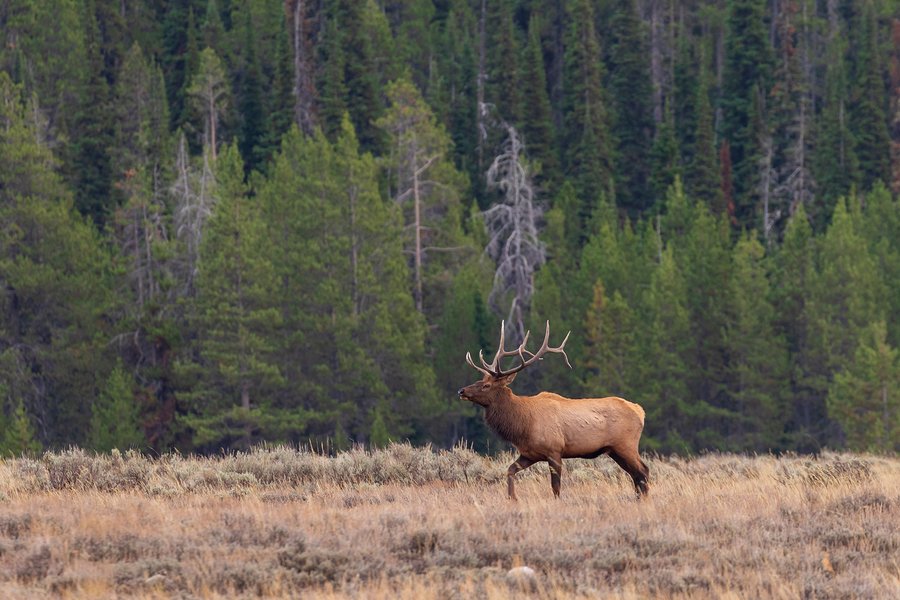
If you type in “elk hunting” in the Wide Open Spaces search bar, you’ll find a ton of information to prepare you for pursuing these animals.
As with moose, they can be a serious load once you get one on the ground, so you had better be in good shape to deal with that task.
Bulls begin bugling during the breeding season, which peaks in late September in most areas. Anyone who has heard this distinctive sound coming from the morning mist will tell you that it’s this communication that makes them so fun to hunt. While bulls can feel the hunting pressure and start to disappear into uncharted areas, it’s not hard for hunters to still get them into bow range using the right calling techniques.
Elk are not easily fooled by their sight, whereas a bull moose has the eyes of someone who just lost their glasses. While both use the wind and their sense of smell well, elk are much tougher to stalk and shoot. This often comes down to the fact that they’re in large herds, meaning there are many more sets of eyes to see your movement, plus nostrils to pick up your scent.
Elk hunting has by far more hunting opportunities than moose due to the sheer number of animals and states where they live. The best elk hunting is still going to cost you some larger license fees, tag applications, and luck with a lottery decision.
Elk Meat vs. Moose Meat
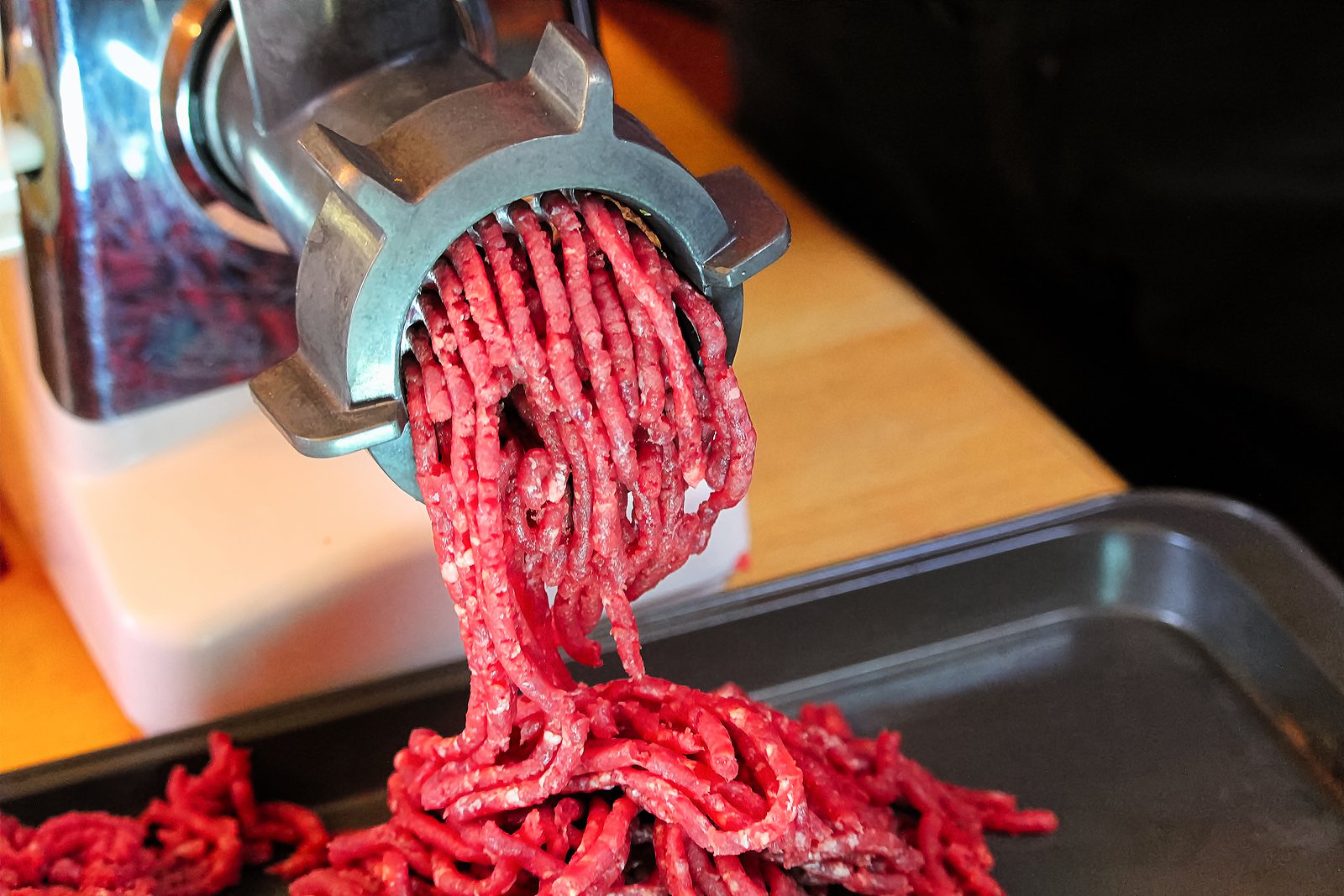
While the antlers or taxidermy mount of an elk or moose can serve as a fine trophy, we still believe the game meat holds a large portion of the importance and overall value of these large hoofed creatures. But the flavor, texture, and overall quality of moose meat and elk meat can vary, as can people’s opinions about them.
Ask a lifelong elk hunter what his or her preference would be, and they just might say moose and vice versa. One of the things that makes wild game meat taste so special is the thought preparation process; there’s plenty of room for error and a poor execution can deem anything subpar.
If I’m pressed to make a personal decision, I can say that I’ve had both many times in my life and my personal choice is moose. Interestingly enough, the largest of the deer is also the most succulent. It might have to do with the majority of aquatic plants they consume. Elk can vary in their diets based on location and other factors, so it seems to me there’s more potential to eat elk meat that I don’t particularly care for. That’s my opinion, anyway.
One thing’s for sure: individual moose and elk can both provide abundant amounts of meat, enough to literally fill a freezer and nourish a family throughout a year. Steaks and roasts are common, but grinding moose meat or elk meat can also be a typical way of using it.
The Bottom Line
Here are the biggest differences up to this point: there are more elk and therefore more hunting options for the species. Moose are generally solitary and more difficult to find, whereas elk gather in numbers. While moose seem to have a disadvantage due to their poor eyesight, they make up for it in other ways. Elk are hunted in multiple regions and habitats, while moose are a northern species and relate most commonly to water and wet environments.
Both species can be quite dangerous animals to hunt, but as many elk hunters will tell you, hunting for elk in grizzly country can make them even more of a challenge!
These two deer species can be found in national parks or the Rocky Mountains on the North American continent from the Alaskan wilderness to the east coast. They have a similar size, mutually impressive antlers, and are two of our favorite wild animal species to hunt.
Deciding which is the better for any reason is up to the individual. Our only hope is that we have given you enough information to get the argument started again, hopefully over a grill full of wild game meat.
Looking for a little more or even hot lunch for your hunting blind? Follow my webpage, or on Facebook and Twitter.
NEXT: 5 TOP RATED DEER HUNTING BOWS
WATCH
The post Moose vs. Elk: The Important Facts, What Tastes Better, and Which to Hunt This Season appeared first on Wide Open Spaces.

